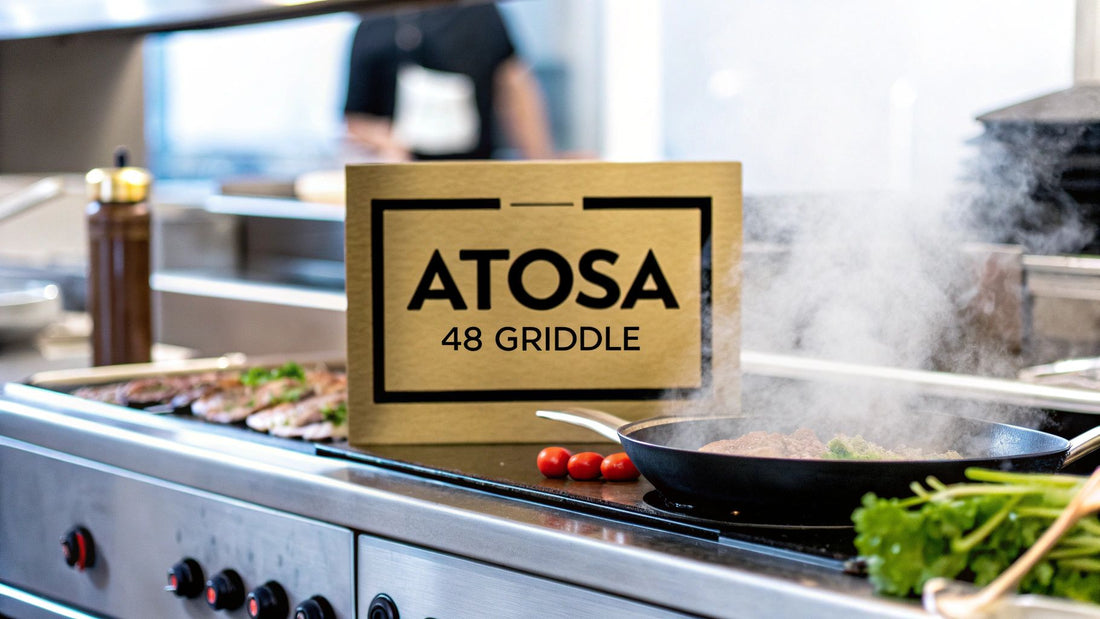
Your Guide to the Atosa 48 Griddle
Share
In any fast-paced kitchen, the real secret to success isn't just a great menu—it's having equipment you can count on. When you're in the weeds, you need gear that's consistent, fast, and built like a tank. That’s exactly where the Atosa 48 griddle comes in. For countless chefs and restaurant owners, it’s not just another piece of equipment; it's the heart of the line for breakfast, lunch, and dinner, representing a smart investment in a rapidly evolving industry.
Introducing Your Kitchen's Next Powerhouse
Picture the morning rush. The tickets are flying, and you need a griddle that can keep pace without breaking a sweat. The Atosa 48 griddle was built from the ground up for exactly that kind of pressure. It’s more than just a flat-top; it’s the command center for your entire menu. With a massive 48-inch surface, your crew has all the room they need to juggle multiple orders at once, from stacks of pancakes and sizzling bacon to perfectly seared burgers.
This isn't just about having more cooking real estate. It's about workflow. A bigger griddle means you can create dedicated zones, eliminate bottlenecks, and shave precious seconds off every ticket. That kind of efficiency doesn't just make the kitchen run smoother—it keeps customers happy and adds directly to your bottom line. We're here to help you stay informed on the equipment and trends that give you a competitive edge.
Built for the Commercial Grind
Let's be honest: professional kitchen equipment takes a beating. It runs hot for hours on end, day in and day out. Durability isn't a bonus feature; it's a requirement. The Atosa 48 griddle gets this. Its heavy-duty stainless steel frame is designed to resist corrosion and handle the daily grind of a commercial kitchen.
This commitment to toughness is most obvious where it matters most: the cooking surface. Take the Atosa CookRite ATMG-48-NG model, for example. It boasts a hefty 3/4" thick polished steel griddle plate. That thickness is key—it holds heat incredibly well and distributes it evenly, eliminating the hot and cold spots that ruin a good sear.
Underneath that plate, you’ll find four burners, each pushing out 30,000 BTUs. With independent controls for each, you get precise command over different cooking zones. It’s this blend of raw power and rugged construction that has made it a go-to for everyone from hotel chefs to the busiest diners in town.
The bottom line: The Atosa 48 griddle is so valuable because it perfectly marries a huge, versatile cooking area with the power and durability required for non-stop, high-volume service. It’s a true cornerstone for any successful kitchen operation.
To really see what this machine offers, let's break down the specs. This table gives you a quick snapshot of the technical details that deliver its impressive performance in the real world.
Atosa 48 Griddle At a Glance
| Specification | Details |
|---|---|
| Total Cooking Width | 48 inches (1219 mm) |
| Griddle Plate Thickness | 3/4" Polished Steel |
| Total BTU Output | 120,000 BTU/hr |
| Burner Configuration | 4 Independent Burners (30,000 BTU each) |
| Control Type | Independent Manual Controls per Burner |
| Gas Type | Natural Gas (LP conversion kit often included) |
| Exterior Construction | Stainless Steel Body and Legs |
| Grease Management | Removable Stainless Steel Grease Drawer |
As you can see, every element is designed for heavy-duty commercial use, from its powerful output to its easy-to-clean features.
Why This Griddle Is a Smart Investment
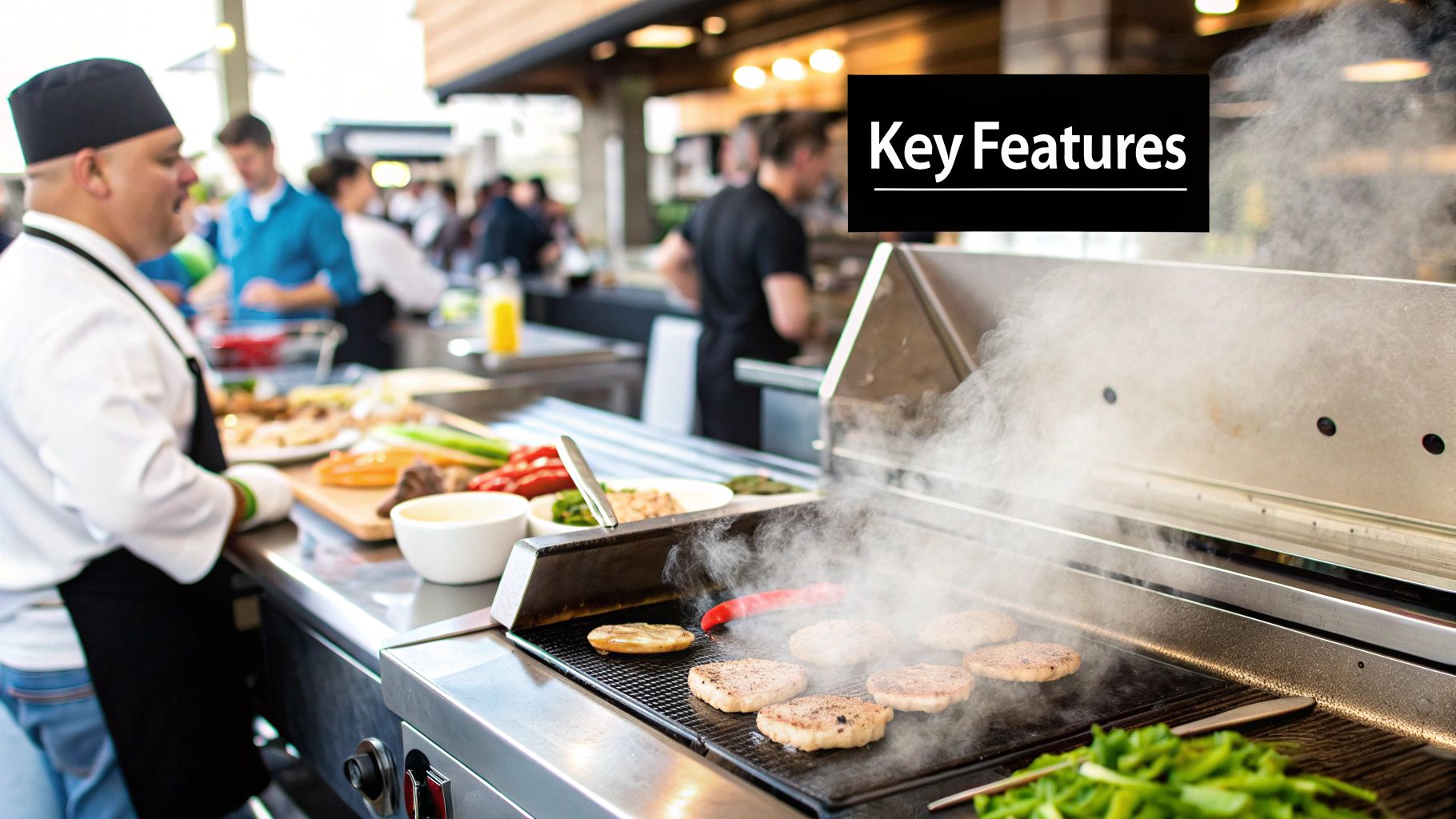
Picking the right equipment for your kitchen is so much more than a simple purchase. It’s a strategic move that directly affects your day-to-day workflow and, ultimately, your bottom line. Any chef or restaurant owner worth their salt knows that putting your money into durable, efficient gear is an investment that pays you back for years to come. The Atosa 48 griddle is a perfect example of that forward-thinking approach.
In the fast-paced world of foodservice, your equipment has to do more than just cook. It needs to be a workhorse—able to handle the relentless pressure of a busy service, keep energy costs in check, and deliver the same great results every single time. This is exactly where the Atosa griddle proves its worth, built from the ground up to tackle these critical demands.
Keeping Pace with a Demanding Industry
The commercial kitchen equipment scene is always changing, and right now, the big conversations are about energy efficiency and equipment that lasts. Even with all the buzz around electric gear, the core idea of getting the most out of your fuel source is just as important for gas appliances. A gas unit like the Atosa 48 griddle uses high-output burners that squeeze every bit of power out of its fuel, converting BTUs directly into cooking performance without waste. Efficiency isn't a bonus anymore; it's a must-have for running a smart kitchen.
This shift is fueled by a booming hospitality sector that needs reliable, high-capacity equipment. Consider this: in 2024, there are over 157,000 hotel rooms being built in the U.S. alone—that's a 7% jump from last year. That growth means a massive demand for dependable kitchen workhorses. Investing in a solid griddle is how you prepare your kitchen to handle that kind of pressure and growth.
Making smart investments starts with a solid plan. For a closer look at what to prioritize when outfitting your space, our commercial kitchen equipment checklist can help you cover all your bases.
Durability Is Your Best Financial Plan
Let’s be honest. Every time a piece of equipment goes down, it costs you. It's not just the repair bill; it's the lost service time, a stressed-out crew, and the risk of unhappy customers. The Atosa 48 griddle, with its tough stainless steel body and thick cooking plate, is specifically designed to prevent that headache.
Think of it this way: an investment in durability is really an investment in uptime. When you choose equipment that’s built to last, you’re cutting down the chances of a costly emergency repair and keeping your kitchen humming, protecting your revenue when it matters most.
This focus on long-term performance has a direct impact on your finances. Fewer breakdowns and a longer lifespan mean a lower total cost of ownership. Instead of throwing money away on constant repairs or replacing a cheaper unit every couple of years, you make one smart buy that works for your business day in and day out.
This is the kind of strategic thinking that sets successful restaurants apart from those always battling operational fires. The Atosa 48 griddle isn't just another line item on your expense sheet; it's a cornerstone asset that strengthens your restaurant's financial stability and operational backbone.
How Core Features Translate to Real Kitchen Wins
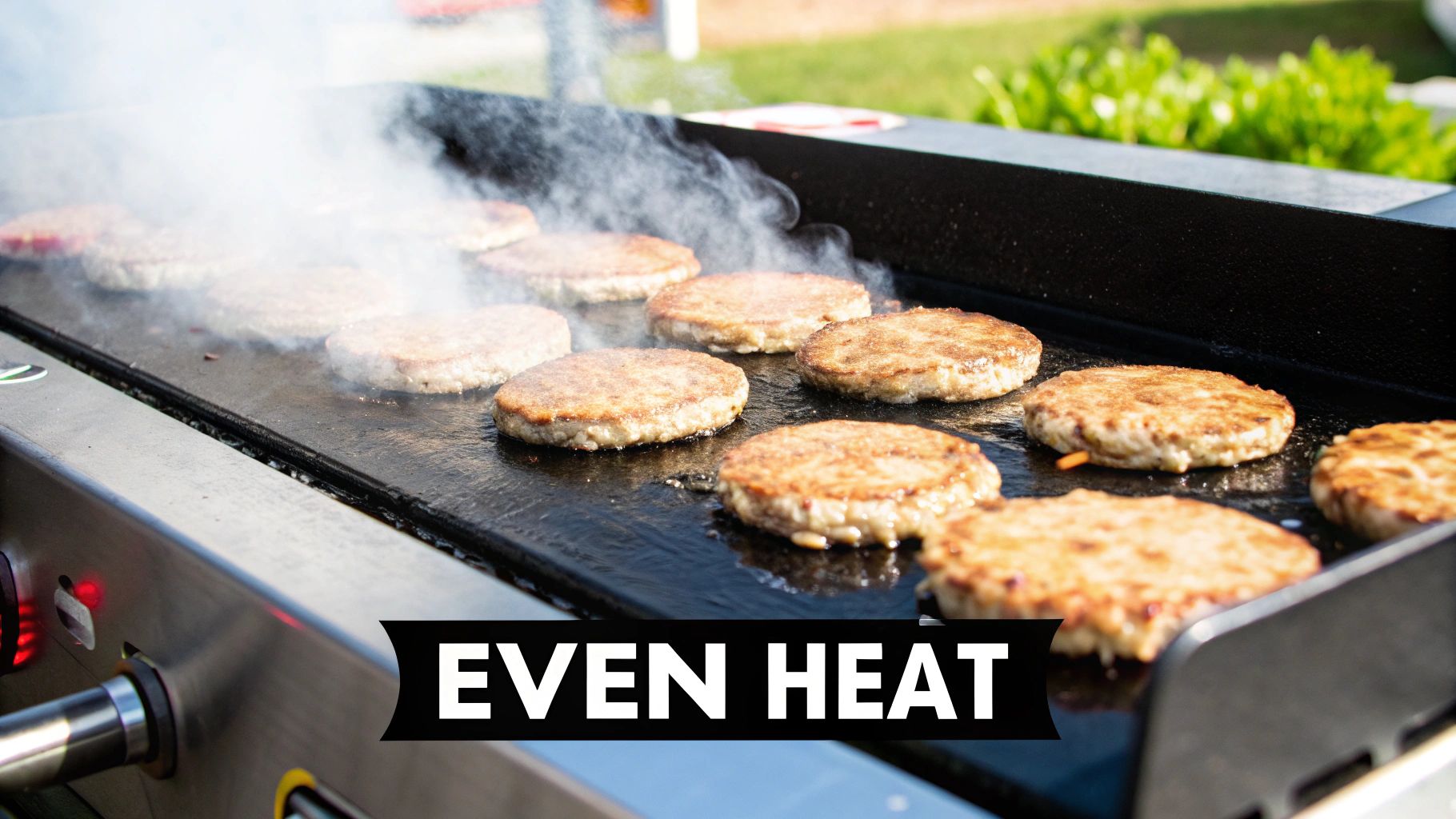
Specs on a sheet are one thing. But how a griddle performs when tickets are flying and the pressure is on? That’s what really counts. The features of an Atosa 48 griddle aren't just technical details; they're direct answers to the daily grind every chef knows all too well.
Seeing how these specs translate into tangible benefits in the kitchen is where you'll grasp the true value of this workhorse. From the thickness of the cooking plate to the layout of the knobs, every element is designed to improve your workflow, elevate your food, and speed up service. It’s all about turning smart engineering into amazing food, shift after shift.
The Powerhouse: A Thick Polished Steel Plate
Right off the bat, one of the standout features is the 3/4-inch thick polished steel plate. This isn't just a slab of metal—it’s a thermal battery. Think of it like a massive cast-iron skillet. That hefty plate soaks up an incredible amount of heat and holds onto it for dear life.
So, what does that actually mean for your cooking?
- No More Hot Spots: Say goodbye to the inconsistent heat that plagues thinner griddles. You get an even cooking surface from one end to the other.
- The Perfect Sear: When you throw down a dozen cold burger patties, the plate’s stored heat prevents a drastic temperature drop. The result is a perfect, crispy sear every single time.
- Insanely Fast Recovery: The griddle gets back up to temperature almost instantly. That means you can turn tables faster without ever waiting on your equipment.
This kind of thermal stability is your secret weapon during a chaotic dinner rush, making sure the last plate of the night is just as flawless as the first. For a deeper dive, check out https://encoreseattle.com/blogs/seattle-restaurant-equipment/your-ultimate-guide-to-the-atosa-griddle for more insights.
Total Command with Independent Controls
The Atosa 48 griddle comes armed with four beefy burners, kicking out a massive 120,000 BTUs of combined power. But power is nothing without control. That's where the independent manual controls for each 12-inch section come in. This is what separates the pros from the amateurs.
Picture a painter’s palette. That’s what these controls give you, but with heat. This ability to create different temperature zones opens up a world of menu flexibility and pure efficiency.
You could have one section cranked up high for searing steaks and charring vegetables, while the zone next to it is holding at a gentle, low heat—perfect for toasting buns or keeping cooked items warm without overdoing them.
This setup lets you tackle complex orders with varying heat needs all at once, on a single surface. You’re not just cooking faster; you’re cooking smarter by getting the most out of every square inch of your griddle. It transforms a simple flat-top into a truly versatile cooking station.
Built Tough for the Daily Grind
Beyond its cooking prowess, the griddle’s design smartly addresses the realities of a commercial kitchen: sanitation and durability. The entire body is built from stainless steel. It’s tough, sure, but it’s also incredibly easy to clean and keep sanitary. It fights off corrosion, laughs at harsh cleaning chemicals, and simply endures the abuse of a busy kitchen.
The grease management system is another brilliant, practical touch. It has a large, slide-out grease drawer that makes the end-of-night cleanup far less of a chore. By simplifying one of the most dreaded kitchen tasks, it helps your team maintain a clean workspace while saving precious time. This practical, real-world focus ensures your Atosa 48 griddle will be a reliable and hygienic cornerstone of your kitchen for years to come.
A Practical Guide to Installation and Setup
Getting your new Atosa 48 griddle unboxed is a great feeling, but a truly successful start involves more than just plugging it in. The truth is, proper installation is the bedrock of safety, performance, and the long-term health of your equipment. This guide will walk you through setting up your griddle the right way, from day one, so you can avoid common headaches and get straight to cooking.
Think of the setup process as the first and most critical phase of your griddle's working life. If you nail this part, all the powerful features we've talked about can truly perform as intended. It all comes down to prepping the space, making safe connections, and getting that cooktop ready for action.
Preparing the Perfect Spot
Before that griddle even crosses your doorway, your first job is to prepare its new home. Where you place your Atosa 48 griddle isn't just about kitchen workflow; it’s about meeting strict safety codes. This thing needs room to breathe.
- Proper Clearance: Commercial cooking equipment throws off a serious amount of heat. You need to check the manufacturer's specs for the required clearances from walls and other gear. A solid rule of thumb is to maintain at least 6 inches of space from any combustible surfaces.
- Ventilation is Non-Negotiable: A commercial-grade ventilation hood isn't just a good idea—it's the law. It’s essential for pulling out heat, grease-filled vapor, and fumes, keeping your kitchen air safe and your staff comfortable. Failing a health inspection over bad ventilation is a costly mistake you can easily avoid.
Once you have the perfect spot picked out, it's time for the most critical step: the gas hookup.
The Gas Connection: A Job for the Pros
Let's be crystal clear: connecting the gas line to your Atosa 48 griddle is a job that must be done by a certified and licensed gas technician. This is absolutely not a DIY project. One wrong move with a gas line can lead to dangerous leaks, fires, or catastrophic damage to the unit, which will instantly void your warranty.
A professional will make sure the gas pressure regulator is installed correctly and that the gas type—whether it's Natural Gas or Propane—matches what your griddle is set up for. After the connection is made, they'll meticulously check every single joint and fitting for leaks. This professional touch is your guarantee that the griddle will operate safely and pass any local fire or building inspections.
Your griddle gets its power from the gas line, but it gets its safety from a flawless installation. Spending the money on a professional technician is the single best decision you can make during setup. It protects your people, your property, and your business.
Leveling for Perfect Cooking and Drainage
With the griddle in place and the gas safely connected, the last physical tweak is getting it perfectly level. The Atosa 48 griddle is equipped with sturdy, adjustable stainless steel legs for this very reason. You'd be surprised how many problems an unlevel griddle can cause.
If the surface is tilted, oil and grease will just pool in one corner. This leads to wildly inconsistent cooking—food ends up soggy on one side and burnt on the other. A perfectly level cooktop ensures heat spreads evenly and allows grease to flow right where it's supposed to: into the grease trap. This makes cleanup far easier and prevents dangerous flare-ups. Just grab a spirit level, place it on the griddle plate, and adjust the legs until that bubble is dead center.
The infographic below shows the simple daily cleaning routine you'll follow once your griddle is all set up and seasoned.
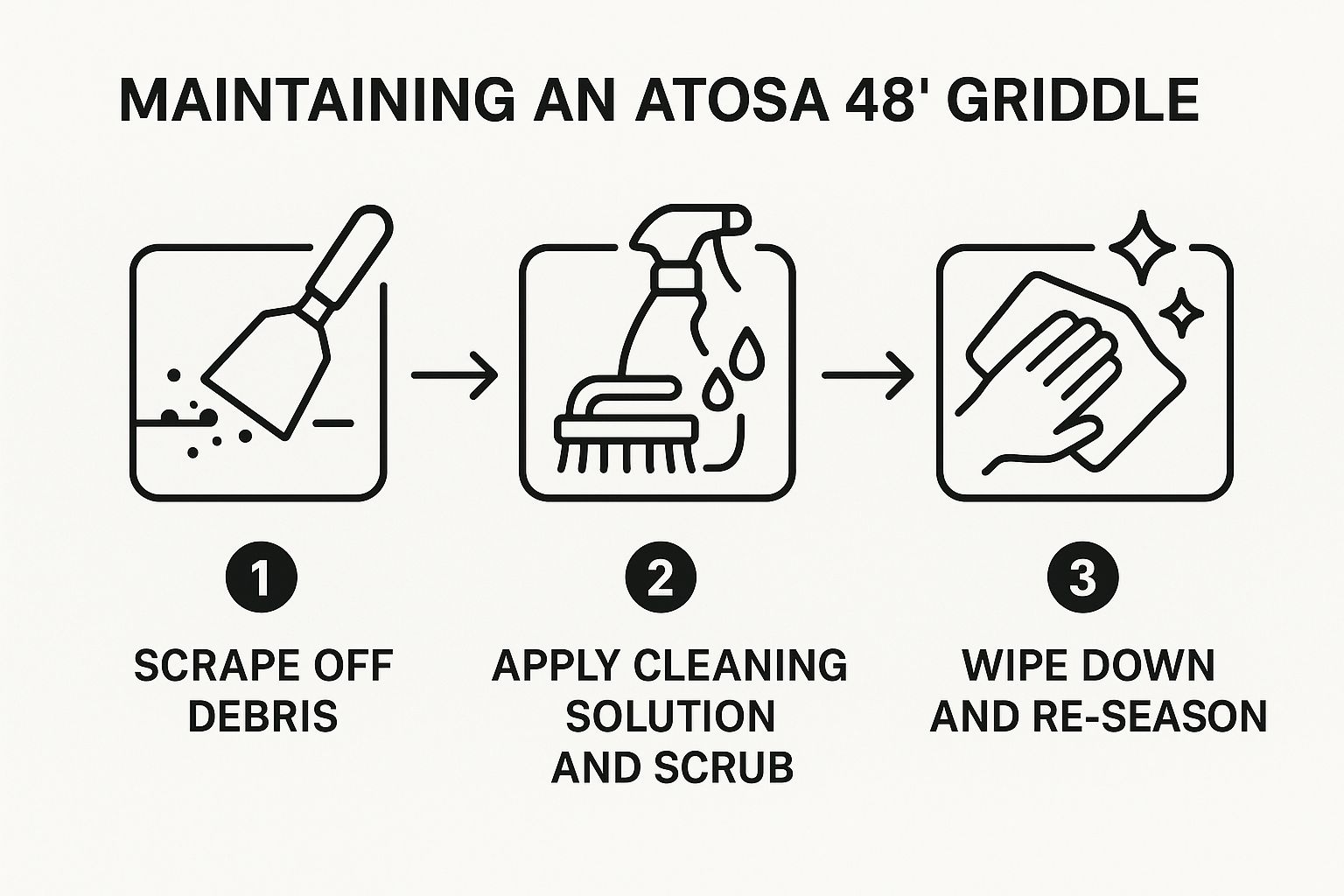
This quick visual guide highlights the repeatable steps that keep the cooking surface in prime condition.
The Crucial First Seasoning
The final, and arguably most important, part of the setup is seasoning the griddle plate. This is the process that creates that beautiful, natural non-stick surface, or patina, that only gets better with time. It not only protects the steel from rust but is also the secret to sliding off perfect pancakes, eggs, and seared steaks.
- Clean the Surface: Start by washing the brand-new griddle plate with a little mild soap and water. This gets rid of any protective oils from the factory. Rinse it well and dry it completely.
- Apply Oil: Turn the griddle on to a medium-high heat, somewhere around 300-350°F. Pour a small amount of a high-smoke-point oil (canola or vegetable oil works great) onto the surface.
- Spread a Thin Layer: Grab a clean, lint-free cloth with some tongs and spread the oil across the entire cooktop. You're aiming for a super thin, even layer.
- Heat Until It Smokes: Let the griddle keep heating up until the oil just starts to smoke. That smoke is the sign that the oil is polymerizing and bonding to the steel.
- Cool and Repeat: As soon as it smokes, kill the heat and let the griddle cool down. Wipe away any excess oil. You'll want to repeat this whole process 3 to 4 times to build up that hard, dark, and slick cooking surface you're looking for.
Once that's done, your Atosa 48 griddle is officially seasoned, prepped, and ready for service.
Mastering Daily Operations and Cooking Techniques
Getting your Atosa 48 griddle unboxed and installed is one thing. But the real magic begins the moment you fire it up. To truly get the most out of this workhorse, you have to understand its personality—how it heats up, how it holds that heat, and how to make it a true extension of your skills in the kitchen.
This isn't just about twisting knobs. It's about developing a feel for the machine. When you master its daily operation, you'll see the results directly in your food, your ticket times, and the overall rhythm of your kitchen. Think of that massive 48-inch steel plate as your canvas; learning to control the heat is your brushstroke.
The Art of the Perfect Pre-Heat
The first and most important rule of griddle cooking is patience. A solid pre-heat is the foundation for everything you cook. If you jump the gun and toss food onto a cold or patchy surface, you're setting yourself up for failure. The food will stick, it will steam instead of sear, and your results will be all over the place.
For the Atosa 48 griddle, you'll want to give it a good 15-20 minutes to pre-heat properly. This gives that heavy 3/4-inch plate time to soak up all that energy and distribute it evenly. That stored heat is your secret weapon, delivering a powerful, consistent sear, even when you slam it with cold burgers during a busy rush.
An old-school water test is a great way to gauge the temperature. Flick a few drops of water onto the surface. If they dance and skitter across the steel before vanishing, you're in the sweet spot. If the water vanishes instantly with a loud hiss, it's probably too hot. If it just sits there and slowly steams, you need more time.
Multi-Zone Cooking for Maximum Efficiency
One of the best things about the Atosa 48 griddle is its independent burner controls. This feature turns a simple flat-top into a dynamic, multi-zone cooking station. By setting different heat levels across its four-foot surface, you can knock out complex orders with incredible precision.
Here’s how that looks in the real world:
- The Breakfast Rush: Set one end to high heat (375-400°F) to get bacon crispy and put a hard sear on sausage. Use the middle for perfect, golden-brown pancakes at a medium heat (325-350°F). Then, keep the far end on low (250-275°F) to hold finished items or gently scramble eggs without turning them rubbery.
- Lunch Service: Crank one zone way up for searing burger patties and locking in the juices. Keep the zone next to it cooler for toasting buns and melting cheese perfectly without burning anything. It’s all about timing, ensuring every part of the burger is ready to go at the exact same moment.
This multi-zone strategy is all about economy of motion. You’re moving less, using every square inch of your griddle, and getting food out of the window faster. This is how the Atosa 48 griddle becomes the engine of your production line.
With this kind of control, a single chef can work with the efficiency of two, which can completely change the flow of your kitchen for the better.
Taming Flare-Ups and Managing Heat
When service gets crazy, things can get hot—literally. Grease and high temperatures can sometimes cause flare-ups. The best defense is a good offense: prevention. Scraping the griddle constantly between orders is non-negotiable. Keep your scraper and grease trough close so you can clear away excess fat and food bits before they have a chance to ignite.
If a small flare-up does happen, don't panic. The worst thing you can do is throw water on it, which will just spatter hot grease everywhere. Simply slide the food away from the flame and use your scraper to push the source—usually a pocket of grease—into the trough.
Managing the temperature during a rush is a skill you build over time. Pay close attention to how the griddle breathes. That thick Atosa plate retains heat incredibly well, but you still need to think one step ahead. If you see a big ticket coming in, you might bump the heat up a touch to compensate for the coming temperature drop, then dial it back down once the food is on. It's this kind of proactive heat management that keeps you in command when the pressure is on.
Keeping Your Atosa 48 Griddle in Prime Condition
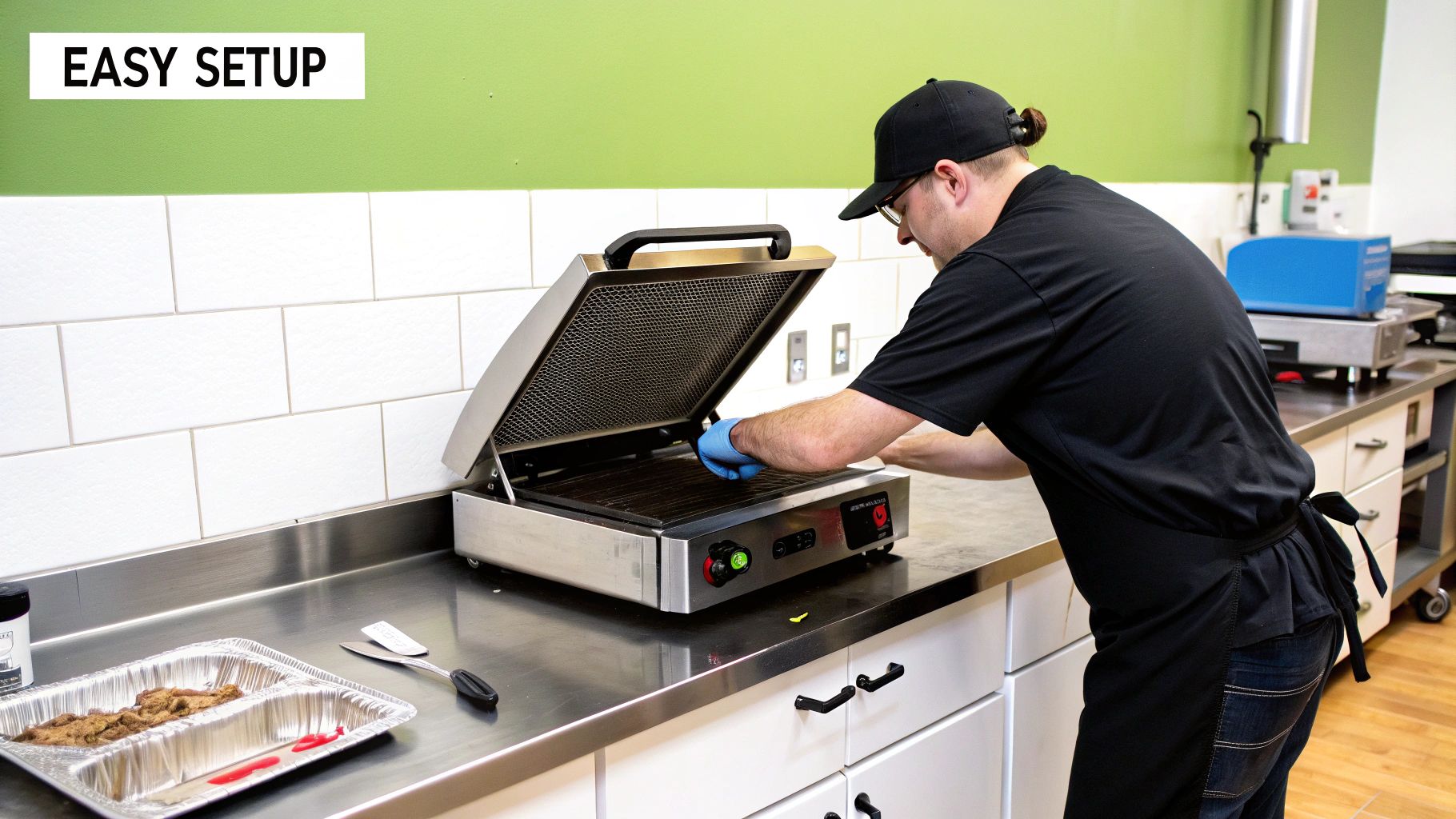
Let's be honest—your Atosa 48 griddle is a workhorse. It's likely one of the most critical pieces of equipment on your line, and you've made a real investment in it. Just like a finely-tuned engine, it needs consistent care to perform day in and day out. Think of a solid maintenance routine as your best insurance policy against surprise breakdowns and the headaches of downtime.
If you let maintenance slide, you're not just risking the life of the griddle; you're compromising food quality. A dirty, neglected surface leads to sticking, hot spots, and weird flavor carryover. A little proactive care goes a long way in protecting both your equipment and your restaurant's reputation.
The Non-Negotiable Daily Shutdown
At the end of every shift, a thorough cleaning isn't just a suggestion—it's essential. This isn't just about passing a health inspection; it's about preserving that perfect, non-stick cooking surface you've worked so hard to build. You're essentially resetting the canvas for the next day's service.
These quick tasks make a huge difference:
- Scrape It While It's Warm: While the griddle is still warm (not scorching hot), grab your scraper. Push all the leftover food bits and grease into the trap. The warmth helps release all that gunk so much more easily.
- Use the Right Tools: A griddle brick or a non-abrasive pad paired with a high-temp griddle cleaner is your best bet. Whatever you do, stay away from harsh chemicals or steel wool—they’ll strip your seasoning right off.
- Wipe Down and Re-Season: Once you’ve scrubbed it, wipe the surface with a clean, damp cloth and dry it completely. Finish by applying a paper-thin layer of cooking oil. This protects the steel and prevents rust overnight.
This simple, five-minute ritual is your best defense against the carbon buildup that causes so many griddle headaches. It’s the same principle as taking care of your other key appliances, and you can learn more about that in our guide to the Atosa freezer. Consistent care across the board is what separates the pros.
Weekly and Monthly Health Checks
Daily cleaning keeps the cooking surface pristine, but you need to look a little deeper to keep the whole unit healthy. These checks are designed to catch small problems before they spiral into big ones.
Once a week, give the grease trap some love. Pull it out, empty it, and give it a good wash in your three-compartment sink with hot, soapy water. Keeping it clean prevents nasty overflows and seriously reduces fire risk.
Pro Tip: Think of your monthly check as an early warning system. Take a minute to look over the gas hoses for any cracks or signs of wear. While you're at it, check that the burner orifices are clear of debris, which can mess with your gas flow and give you uneven flames.
Quick Fixes to Try Before Calling a Technician
Even the best-maintained griddle can act up sometimes. Before you pick up the phone for a service call, a little know-how can often get you back up and running.
Common Griddle Problems & First Steps
| Problem | Possible Cause | What to Check First |
|---|---|---|
| Uneven Heating | The burner ports are clogged, or there's buildup on the griddle plate. | After a deep clean, fire it up and check the flames. They should be a consistent blue. If you see blockages, you can gently clear the ports with a paperclip. |
| Pilot Light Won't Stay Lit | The thermocouple might be dirty or has been knocked out of position. | Make sure the pilot flame is completely touching the tip of the thermocouple. You can also gently wipe the thermocouple with a dry cloth to remove any carbon. |
| Food is Sticking Badly | Your seasoning layer has been damaged or stripped away. | It's time to re-season. Go through the initial seasoning process again to rebuild that slick, non-stick surface. |
Running through these simple diagnostics for your Atosa 48 griddle can often solve the issue on the spot, keeping your kitchen humming along without interruption. If the problem continues after you've tried these fixes, then it’s time to bring in a certified technician.
Got Questions? We've Got Answers
When you're thinking about adding a workhorse like the Atosa 48 griddle to your kitchen, a few questions always pop up. It's a big decision, and you need to know you're making the right one. Let's walk through some of the most common things chefs and owners ask us, so you can feel totally confident.
What's the Real Difference: Manual vs. Thermostatic Griddles?
It all boils down to how you want to manage your heat. A manual griddle, like the standard Atosa 48 griddle, puts you in the driver's seat. You get simple knobs—low, medium, high—for direct control over the flame. Many seasoned chefs love this setup because they can "feel" the heat and make adjustments on the fly. It's responsive and intuitive.
A thermostatic griddle is more like your oven at home. You dial in an exact temperature, say 350°F, and the griddle does the rest, cycling its burners on and off to hold that temp steady. This is a fantastic feature for consistency, especially if you have a lot of different cooks on the line or need to nail specific temperatures for delicate items.
Think of it this way: a manual griddle is like driving a stick shift—you have complete control. A thermostatic model is like an automatic transmission; it handles the fine-tuning for you.
How Do I Get That Perfect Seasoning on the Atosa 48 Griddle?
That slick, non-stick surface you see on a well-loved griddle doesn't happen by accident—it's built. Seasoning your new griddle plate is the most important thing you can do right out of the box. First, give it a quick wash with mild soap and water to get rid of any residues from the factory, then rinse and dry it thoroughly.
Now for the magic. Fire up the griddle to a medium-high heat, somewhere in the 300-350°F range. Pour on a little high-smoke-point oil (canola or vegetable oil works great) and use a clean cloth to spread a very thin layer over the entire plate. Let it cook until the oil just starts to smoke, then shut it down and let it cool completely before wiping off any excess oil. You'll want to repeat this process three or four times to build up that beautiful, dark patina that makes cooking a dream and cleanup a breeze.
Can I Run the Atosa 48 Griddle on Propane?
Absolutely. Most Atosa griddles ship from the factory ready for Natural Gas (NG), but they include a kit to convert them for Liquid Propane (LP) use.
Here’s the crucial part: this conversion must be done by a qualified and licensed gas technician. This isn't a DIY project. The process involves swapping out small parts called orifices and adjusting the gas regulator, and getting it wrong is incredibly dangerous. Trying to do it yourself will void the warranty on your Atosa 48 griddle and creates a serious safety risk. If you need propane, just make sure the model you're buying comes with the LP conversion kit.
Ready to feel the power and reliability of an Atosa griddle in your own kitchen? Here at Encore Seattle Restaurant Equipment, we live and breathe this stuff. We have the expertise and the stock to get you the right gear to help your business thrive. Our goal is to keep you informed about the latest industry trends and exclusive deals on the restaurant equipment you rely on.
Explore our collection of commercial griddles and other essential kitchen equipment today.
